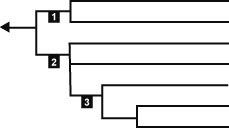| NIES-MCC | KU-MACC | Tree to Strain | Japanese | English |
| Life / Eukarya / Opisthokonta | |

|
Cristidiscoidea (Nuclearia, Fonticula etc.) Fungi (microsporidia, chytrids, yeasts, molds, mushrooms etc.) Ichthyosporea (Ichthyophonus, Amoebidium etc.) Corallochytrea (Corallochytrium) Filasterea (Capsaspora, Ministeria) Choanoflagellates (Monosiga, Codosiga, Salpingoeca etc.) Metazoa (sponges, corals, C. elegans, "Drosophila", vertebrates etc.) |
|
1. Holomycota 2. Holozoa 3. Filozoa |
|
| Refereces |
|
|
The Opisthokonta is a large supergroup of eukaryotes including metazoans and fungi. In addition, the Opisthokonta also includes some flagellate (choanoflagellates), amoeboid (e.g. Nuclearia) and sporozoan (e.g. Ichthyosporea, Microsporidia) protists. The opisthokonts are phagotrophic or osmotrophic (saprobic, parasitic). Some membrs live symbiotically with land plants or algae (e.g. lichens, mycorrhizal fungi, corals). One of the most characteristic features of the Opisthokonta is the architecture of flagellate cell, and this feature is origin of the name 'Opistho-konta'. Flagellate cell possesses a single flagellum inserted posteriorly. Mitochondrial cristae are usually flat. The opisthokonts sometimes possess 'filipodia' supported by actin filaments. The filopodia are tapering and branching in fungi and nucleariids, but those (sometimes called 'tentacles') are not in the Filozoa. In the choanoflagellates and sponges (Metazoa), the filopodia form a particle-capturing apparatus, the collor arround flagellum. Metazoa has the most advanced multicellular organization. Some proteins for intercellular junction and interaction are found in Ministeria. Because Corallochytrium (Corallochytrea) possess α-aminoadipate reductase (α-AAR) involved in the α-aminoadipate (AAA) pathway, this organism is sometimes considered to be closely related to fungi than to animals (Sumathi et al. 2006. Protist 157: 363-376). Protistan opisthokonts are sometimes classified into the Choanozoa or Mesomycetozoa. However, these taxa in this sense are not monophyletic. The microsporidia and myxozoans were traditionally classified into protozoa (sporozoa). However, recent studies indicate that they are simplified fungi and animals, respectively. |
 1: Ceriodaphnia (Animalia). 2: Salpingoeca (Choanoflagellates). 3: Nuclearia (Cristidiscoidea). 4: mushroom (Fungi). 5: Macaca (Animalia). 6: Allomyces (Fungi). |